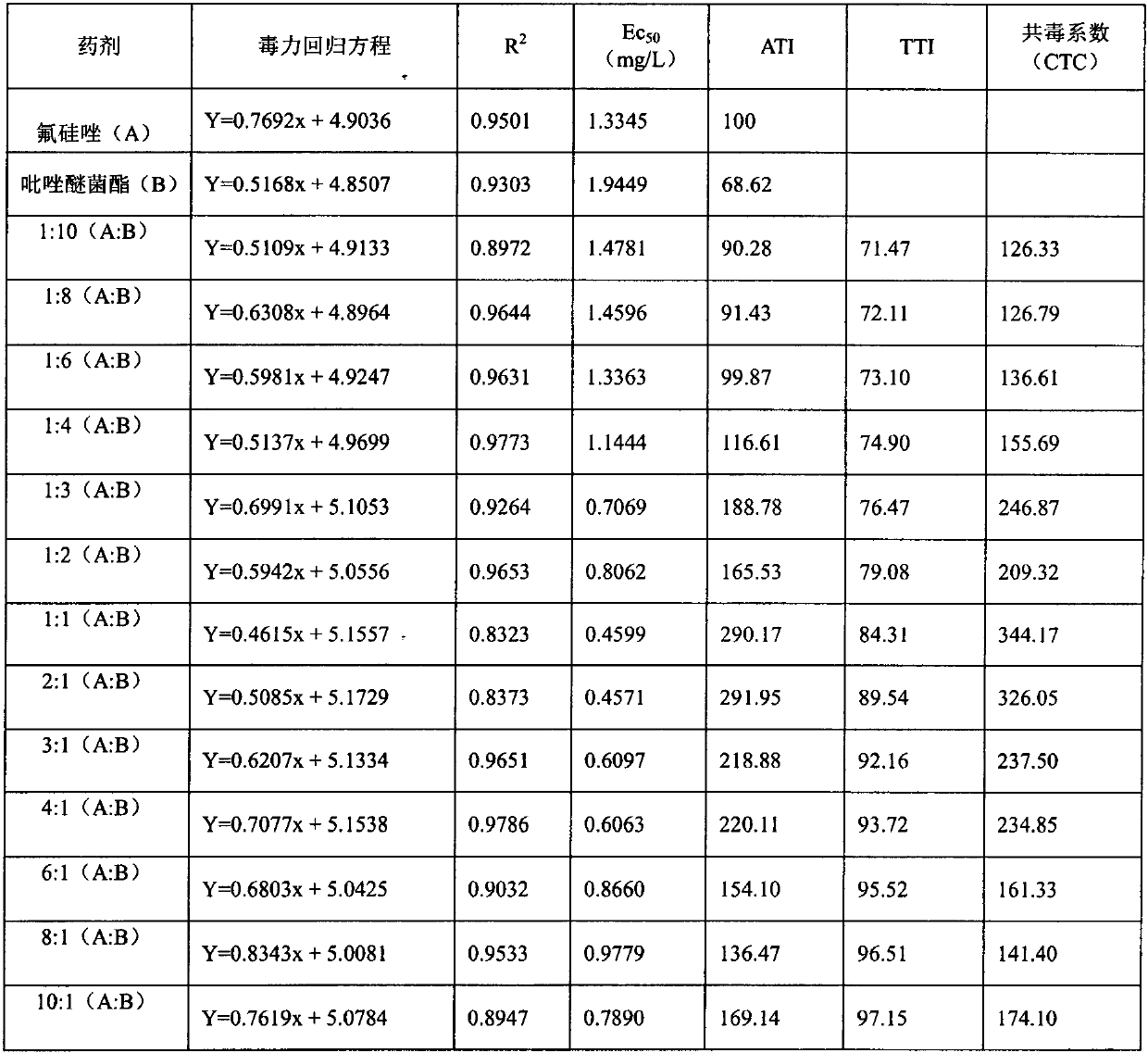Bactericidal composition for controlling main fungal diseases of pears and application thereof
A technology of fungal diseases and compositions, which is applied in the field of fungicidal compositions for the prevention and treatment of main fungal diseases of pears, to achieve the effects of reducing pollution, improving utilization efficiency and duration, and expanding the spectrum of disease prevention
- Summary
- Abstract
- Description
- Claims
- Application Information
AI Technical Summary
Problems solved by technology
Method used
Image
Examples
Embodiment 1
[0023] Example 1: Indoor bioassay of flusilazole and pyraclostrobin compounded against black spot fungus of pear
[0024] Using the mycelial growth rate method in the room, measure the EC50 value of different agents inhibiting the mycelial growth of Pyrethia spp., and use the co-toxicity coefficient calculation method to calculate the co-toxicity coefficient (CTC) of the mixture to determine the synergy of the mixture , the specific calculation method is as follows:
[0025] Use a single agent in the mixture as the standard agent (usually EC 50 The lower one), the other single agent is the test drug, and the calculation is performed:
[0026] Single dose toxicity index = standard dose EC 50 / Test agent EC 50 ×100
[0027] Theoretical toxicity index (TTI) = Toxicity index of A single dose × Proportion of A single dose in the mixture + Toxicity index of B single dose × Proportion of B single dose in the mixture
[0028] Actual Toxicity Index (ATI) = EC of a standard single ...
Embodiment 2
[0035] Example 2 Indoor bioassay of flusilazole and pyraclostrobin compounded against Pyrethria spp.
[0036] The mycelial growth rate method was used indoors to measure the EC of the optimal ratio combination of flusilazole and pyraclostrobin 1: 1 and 2: 1 inhibiting the mycelial growth of R. 50 value, adopt the co-toxicity coefficient calculation method, calculate the co-toxicity coefficient (CTC) of the mixture, determine the synergism of the mixture, and the specific calculation method is carried out with reference to the method in embodiment 1.
[0037] Table 2 Indoor bioassay results of the inhibitory effect of flusilazole and pyraclostrobin on different ratios of pyraclostrobin
[0038]
[0039] The above laboratory bioassay results showed that flusilazole and pyraclostrobin had a synergistic effect on the inhibition of mycelia growth of R. 153.98, 154.15.
Embodiment 3
[0040] Example 3 Indoor bioassay of pear anthracnose bacteria compounded with flusilazole and pyraclostrobin
[0041] Using the mycelial growth rate method indoors, the EC of the optimal ratio combination of flusilazole and pyraclostrobin 1: 1 and 2: 1 in Example 1 inhibiting the mycelial growth of pear anthracnose 50 value, adopt the co-toxicity coefficient calculation method, calculate the co-toxicity coefficient (CTC) of the mixture, determine the synergism of the mixture, and the specific calculation method is carried out with reference to the method in embodiment 1.
[0042] Table 3 Indoor bioassay results of different ratios of flusilazole and pyraclostrobin on the inhibition of pear anthracnose
[0043]
[0044] The above laboratory bioassay results showed that when flusilazole and pyraclostrobin were compounded at a ratio of 2:1, their inhibitory effects on the mycelial growth of P. pear anthracnose were additive, and the co-toxicity coefficient (CTC) was 99.77.
PUM
 Login to View More
Login to View More Abstract
Description
Claims
Application Information
 Login to View More
Login to View More - R&D
- Intellectual Property
- Life Sciences
- Materials
- Tech Scout
- Unparalleled Data Quality
- Higher Quality Content
- 60% Fewer Hallucinations
Browse by: Latest US Patents, China's latest patents, Technical Efficacy Thesaurus, Application Domain, Technology Topic, Popular Technical Reports.
© 2025 PatSnap. All rights reserved.Legal|Privacy policy|Modern Slavery Act Transparency Statement|Sitemap|About US| Contact US: help@patsnap.com



